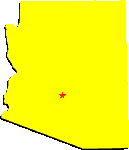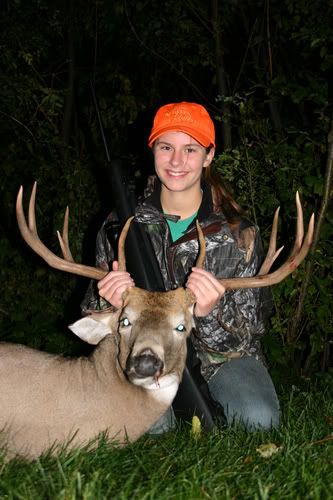
It’s too late to apply for a Wyoming Mule Deer Hunt, but you can still apply for a “brownie point”.
——————————————
“The Department shall allocate not less than seventy-five percent (75%) of the available nonresident Elk, Deer and Antelope licenses to a preference point drawing and twenty-five percent (25%) of the available nonresident Elk, Deer and Antelope licenses will be assigned to a random drawing in which all unsuccessful applicants from the preference point drawing shall be placed.
For party applications, the number of preference points for each applicant within the party will be averaged for the preference point ranking to be used for the ranking in the preference point drawing.
Purchasing ONLY A PREFERENCE POINT can ONLY OCCUR from July 1, 2008 through September 30, 2008. DO NOT ATTEMPT TO PURCHASE A PREFERENCE POINT ONLY during any of the initial license application periods. YOU MUST WAIT until July 1st to purchase only a Preference Point. The price is $50.00 for Elk, $40.00 for Deer and $30.00 for Antelope ($10.00 for youth for each species). There is NO APPLICATION FEE TO PURCHASE A PREFERENCE POINT ONLY.
REMEMBER, a PREFERENCE POINT ONLY PURCHASE is DIFFERENT THAN an application for a license with a PREFERENCE POINT OPTION. THE PREFERENCE POINT OPTION takes place during the initial license application periods. If you elect this OPTION when applying for an Elk, Deer or Antelope license, the fee, which you must remit with your application for a regular elk license, is $641.00 ($14.00 application fee, $577.00 license fee and $50.00 preference point fee). Regular deer license is $366.00 ($14.00 application fee, $312.00 license fee and $40.00 preference point fee). Regular antelope license is $316.00 ($14.00 application fee, 272.00 license fee and $30.00 preference point fee).
To purchase a Preference Point, an applicant must be at least eleven (11) years old at the time of application and be at least twelve (12) years old by December 31 of the year of application.
An applicant may fail to apply for a license or fail to purchase a Preference Point for one (1) year without losing accumulated Preference Points. However, if an applicant fails to properly apply for a license or purchase a Preference Point for two consecutive years, the accumulated Preference Points will be deleted.
The Preference Point system is designed to award a point for each unsuccessful draw attempt in a hard to draw area for individuals who elect the PREFERENCE POINT OPTION and remit the additional Preference Point fees, yet not penalize those who wish to list an easier to draw area on their second or third choice. If a person draws on the second or third choice when electing the PREFERENCE POINT OPTION, a Preference Point will be awarded even though a license is issued. If the person is successful in drawing his or her first choice, then all Preference Points are deleted but the preference point fee paid for that year is refunded. DRAWING A SECOND OR THIRD CHOICE DOES NOT CAUSE PREFERENCE POINTS TO BE DELETED.
Some suggestions when applying for licenses with the PREFERENCE POINT OPTION: DO NOT apply for an easy to draw area for your first choice. If you do and are successful, then all of your accumulated preference points will be deleted and the odds of drawing a license in a hard to draw area may be greatly diminished for the next couple of years. For example, a person applying for Antelope might list area 57/type 1 as a first choice and area 26/type 1 as the second. Based on past years, drawing odds in area 57/type 1 are less than ten (10) percent but area 26/type 1 has been a 100 % draw on all choices. Under the Preference Point system, a person, if not drawn for area 57 would be issued a Preference Point for Antelope if he or she elected the PREFERENCE POINT OPTION, and would also be awarded an area 26 Antelope license if the additional Preference Point fee was remitted as identified above.
To summarize, please remember there is a difference between PREFERENCE POINT ONLY PURCHASES and an application for a license with the PREFERENCE POINT OPTION. A PREFERENCE POINT ONLY PURCHASE APPLICATION (no chance to draw a license) CAN ONLY be submitted from July 1, 2008 through September 30, 2008. An application for a license with the PREFERENCE POINT OPTION can only be made during the applicable initial draw periods.
If you have any doubt, please call (307) 777-4600 or go to our Web Site at http://gf.state.wy.us where the difference between PREFERENCE POINT ONLY PURCHASES and PREFERENCE POINT OPTIONS WITH LICENSE APPLICATIONS will be further explained.“
Click here for more info:


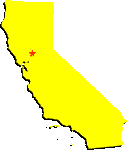

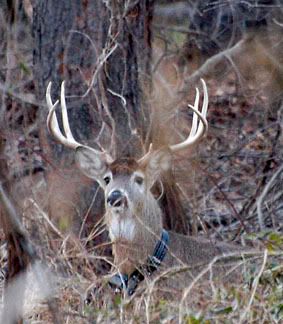 One of the animals they are tracking is a buck named Thor. Thor looks a little like a whitetail, but is really a mule deer – you can tell by the size. He looks pretty suave with his collar, don’t you think? How would you like to track a big buck, like this, for a while?
One of the animals they are tracking is a buck named Thor. Thor looks a little like a whitetail, but is really a mule deer – you can tell by the size. He looks pretty suave with his collar, don’t you think? How would you like to track a big buck, like this, for a while?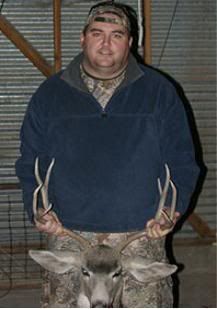 As for Mr. Turk, he was a successful Mule Deer hunter in SE New Mexico, where his family owns a sizeable ranch, by harvesting this 10pt. (Eastern Count) buck mule deer. The buck has an extra cheater which is not visible in the picture. This buck was harvested in 2007. According to Mr. Turk, the herd numbers were down, but his party managed to harvest several nice bucks.
As for Mr. Turk, he was a successful Mule Deer hunter in SE New Mexico, where his family owns a sizeable ranch, by harvesting this 10pt. (Eastern Count) buck mule deer. The buck has an extra cheater which is not visible in the picture. This buck was harvested in 2007. According to Mr. Turk, the herd numbers were down, but his party managed to harvest several nice bucks.
